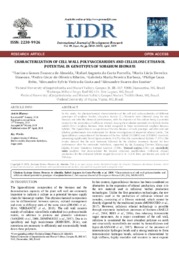Characterization of cell wall polysaccharides and cellulosic ethanol potential in genotypes of sorghum biomass.
Characterization of cell wall polysaccharides and cellulosic ethanol potential in genotypes of sorghum biomass.
Author(s): ALMEIDA, L. G. F. de; PARRELLA, R. A. da C.; SIMEONE, M. L. F.; RIBEIRO, P. C. de O.; BARBOSA, G. M. P.; BRITO, P. L.; COSTA, A. S. V. da; SANTOS, A. S. dos
Summary: In this study, the physicochemical characterization of the cell wall polysaccharides of different genotypes of sorghum bicolor, (Sorghum bicolor (L.) Moench) were obtained using the raw biomass and after the chemical pretreatments, with the objective of this culture being a potential source for the production of cellulosic ethanol. Among the evaluated materials two hybrids brown midrib (bmr) sorghum biomass were tested compared to three conventional sorghum biomass hybrids. The lignocellulosic composition of the raw biomass of each genotype, and after acid and alkaline pretreatments was determined for future investigations of improved ethanol yields. The lignocellulosic composition of the biomass of the bmr hybrid 2015B002 and 2015B003 stood out, presenting significantly lower lignin contents (4.63%) than the conventional hybrids (7.15%).The results showed that the acid treatment followed by the alkaline treatment showed the best performance after the enzymatic hydrolysis, supported by the Scanning Electron Microscopy (SEM), Fourier Transform Infrared Analysis (FTIR), Thermal analysis (TG) and crystallinity index analyzes that demonstrated the desired structural modification. Cellulosic ethanol production for the evaluated hybrids ranged from 6,612 to 11,838 liters per hectare per cycle of 180 days.
Publication year: 2019
Types of publication: Journal article
Unit: Embrapa Maize & Sorghum
Keywords: Celulose, Hidrólise enzimática, Nervura, Rendimento de açúcar, Sorghum Bicolor
Observation
Some of Embrapa's publications are published as ePub files. To read them, use or download one of the following free software options to your computer or mobile device. Android: Google Play Books; IOS: iBooks; Windows and Linux: Calibre.
Access other publications
Access the Agricultural Research Database (BDPA) to consult Embrapa's full library collection and records.
Visit Embrapa Bookstore to purchase books and other publications sold by Embrapa.

